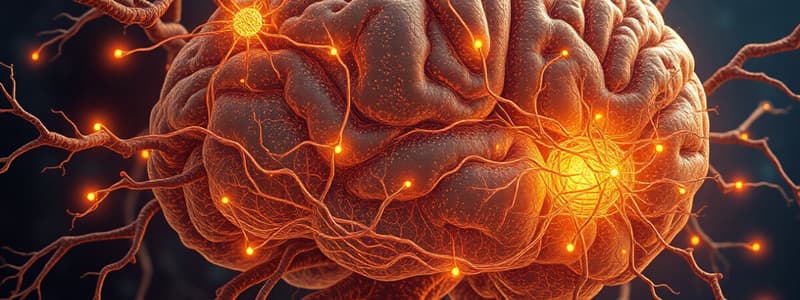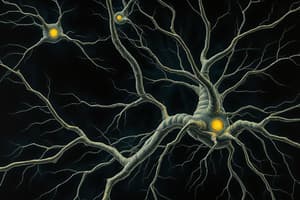Podcast
Questions and Answers
What are the primary components of the central nervous system (CNS)?
What are the primary components of the central nervous system (CNS)?
- Somatic and autonomic nervous system
- Brain and peripheral nerves
- Spinal cord and sensory receptors
- Brain and spinal cord (correct)
Which of the following best describes the role of the autonomic nervous system?
Which of the following best describes the role of the autonomic nervous system?
- Transmits sensory information to the brain
- Manages reflex actions
- Regulates essential bodily functions unconsciously (correct)
- Controls voluntary muscle movements
What is the function of dendrites in a neuron?
What is the function of dendrites in a neuron?
- Transmit electrical impulses away from the cell body
- Protect the axon from damage
- Receive neurotransmitters for communication (correct)
- Provide energy for neuronal metabolism
Which statement is true regarding the sympathetic division of the autonomic nervous system?
Which statement is true regarding the sympathetic division of the autonomic nervous system?
Which type of neuron is primarily involved in transmitting information from sensory organs to the central nervous system?
Which type of neuron is primarily involved in transmitting information from sensory organs to the central nervous system?
What initiates the action potential in a neuron?
What initiates the action potential in a neuron?
What happens to neurotransmitters after they are released into the synaptic cleft?
What happens to neurotransmitters after they are released into the synaptic cleft?
Which process refers to the formation of new neurons?
Which process refers to the formation of new neurons?
What role do SSRI's play in synaptic transmission?
What role do SSRI's play in synaptic transmission?
In what part of the brain is grey matter primarily located?
In what part of the brain is grey matter primarily located?
What is a neuron's resting state characterized by?
What is a neuron's resting state characterized by?
What phenomenon describes the brain's ability to adapt and change over time?
What phenomenon describes the brain's ability to adapt and change over time?
Which type of neuroscience studies the genetic and cellular basis of nervous system function?
Which type of neuroscience studies the genetic and cellular basis of nervous system function?
What is the primary effect of synaptic pruning?
What is the primary effect of synaptic pruning?
Which of the following processes is NOT involved in neuronal death?
Which of the following processes is NOT involved in neuronal death?
What is the primary role of neurotransmitters in the synapse?
What is the primary role of neurotransmitters in the synapse?
How does synaptic plasticity primarily affect the brain?
How does synaptic plasticity primarily affect the brain?
Which of the following statements correctly describes an agonistic drug?
Which of the following statements correctly describes an agonistic drug?
What is the primary impact of neurogenesis on the brain?
What is the primary impact of neurogenesis on the brain?
What does the process of synaptogenesis refer to?
What does the process of synaptogenesis refer to?
Which factor does NOT significantly affect neuronal signaling?
Which factor does NOT significantly affect neuronal signaling?
When action potential reaches the axon terminal, what happens?
When action potential reaches the axon terminal, what happens?
What is the main characteristic of grey matter in the brain?
What is the main characteristic of grey matter in the brain?
Which process is associated with the reabsorption of neurotransmitters after they perform their function?
Which process is associated with the reabsorption of neurotransmitters after they perform their function?
What is functional reorganization in the context of the brain?
What is functional reorganization in the context of the brain?
What is the main difference between the sympathetic and parasympathetic divisions of the autonomic nervous system?
What is the main difference between the sympathetic and parasympathetic divisions of the autonomic nervous system?
Which part of a neuron is primarily responsible for carrying electrical impulses away from the cell body?
Which part of a neuron is primarily responsible for carrying electrical impulses away from the cell body?
Which type of neuron has a single axon and a single dendrite and is often involved in sensory processes?
Which type of neuron has a single axon and a single dendrite and is often involved in sensory processes?
What is the primary purpose of the myelin sheath surrounding an axon?
What is the primary purpose of the myelin sheath surrounding an axon?
Which aspect of the somatic nervous system primarily describes its function?
Which aspect of the somatic nervous system primarily describes its function?
Flashcards
Central Nervous System (CNS)
Central Nervous System (CNS)
The brain and spinal cord, responsible for processing and coordinating information.
Peripheral Nervous System (PNS)
Peripheral Nervous System (PNS)
All nerves extending from the CNS, connecting to the rest of the body.
Somatic Nervous System
Somatic Nervous System
The part of the nervous system that controls voluntary movements and sensory information.
Neuron
Neuron
Signup and view all the flashcards
Autonomic Nervous System
Autonomic Nervous System
Signup and view all the flashcards
Action Potential
Action Potential
Signup and view all the flashcards
Synapse
Synapse
Signup and view all the flashcards
Neurotransmitters
Neurotransmitters
Signup and view all the flashcards
SSRI
SSRI
Signup and view all the flashcards
Cortex
Cortex
Signup and view all the flashcards
Neuroplasticity
Neuroplasticity
Signup and view all the flashcards
Synaptogenesis
Synaptogenesis
Signup and view all the flashcards
Synaptic Pruning
Synaptic Pruning
Signup and view all the flashcards
Neurobiology
Neurobiology
Signup and view all the flashcards
Systems Neuroscience
Systems Neuroscience
Signup and view all the flashcards
Sympathetic nervous system
Sympathetic nervous system
Signup and view all the flashcards
Parasympathetic nervous system
Parasympathetic nervous system
Signup and view all the flashcards
Multipolar neuron
Multipolar neuron
Signup and view all the flashcards
Dendrites
Dendrites
Signup and view all the flashcards
Resting potential
Resting potential
Signup and view all the flashcards
SSRIs (Selective Serotonin Reuptake Inhibitors)
SSRIs (Selective Serotonin Reuptake Inhibitors)
Signup and view all the flashcards
Neurogenesis
Neurogenesis
Signup and view all the flashcards
Study Notes
Central Nervous System (CNS)
- CNS comprises the brain and spinal cord.
Peripheral Nervous System (PNS)
- PNS connects the CNS to the rest of the body.
- Somatic Nervous System:
- Transmits sensory information and controls voluntary movement.
- Sensory (sensation)
- Motor (muscle contraction, movement)
- Via spinal nerves (spinal cord)
- Via cranial nerves (brainstem)
- Autonomic Nervous System:
- Maintains essential bodily functions without conscious control.
- Breathing, pupil dilation, sexual arousal, swallowing, digestion
- Sympathetic ("fight or flight")
- Parasympathetic ("rest and digest")
Neurons
- Fundamental units of the nervous system.
- Cell body: Maintains the cell (metabolism).
- Axon: Myelin-coated fiber carrying electrical impulses.
- Dendrite: Receives neurotransmitters for communication.
Types of Neurons
- Multipolar
- Pyramidal
- Purkinje
- Bipolar
- Unipolar
Neuronal Communication
- Action potential: Electrical signal traveling down the axon.
- Ion channels allowing ions to flow, creating a negative charge inside the axon and a positive charge outside.
- Sodium and potassium channels are closed when the neuron is at rest.
- Depolarization: Temporary shift in membrane potential (negative to positive) due to action potential.
- Communication via synapses (where neurons meet).
- Action potential triggers neurotransmitter release into the synaptic cleft.
- Neurotransmitters bind to specific receptors on the receiving neuron.
- Receptors are neurotransmitter-specific, activated only by their corresponding neurotransmitter or by a chemical that mimics it.
Synapses
- Postsynaptic receptors, when activated, open ion channels.
- Enzymes break down free neurotransmitters.
- Neurotransmitters are reabsorbed by the axon terminal.
Drug Action
- Drugs affect neurotransmission in various ways.
- SSRIs block serotonin reuptake.
- Agonists mimic neurotransmitters to trigger receptors.
- Antagonists block receptors.
- Some drugs directly affect ion channels
Biological Factors Affecting Neurons
- Proteins can malfunction (e.g., Alzheimer's).
- Cell generation, regeneration, and metabolism are crucial (neurodevelopment, stem cells).
- Other aspects of body's metabolism (oxygen, glucose, hormones, nutrients) are also important
Brain Structure
- Grey matter: Cell bodies (brain's computation centers).
- White matter: Axons (brain's cabling).
- Fatty tissue gives white matter its color.
- Cortex: Outer layer of grey matter, highly folded for increased surface area, responsible for higher cognitive functions.
Neuroplasticity
- Brain's ability to change structure/function due to experience.
- Synaptic plasticity: Changes in connection strengths between synapses.
- Synaptogenesis and synaptic pruning: Creation and removal of synapses.
- Neurogenesis: Creation of new neurons.
- Neuronal migration: Neurons moving from their origin to their destination.
- Neural cell death (damage, over-excitation, disease, apoptosis).
- Functional reorganization: Redistributing brain functions (e.g., blind person reading braille).
- Practice can reduce brain activity associated with a task.
Neuroscience Methods
- Direct interventional studies (drugs, lesions, genetic changes, electrical stimulation).
- Measurement of brain tissue (in vivo, post-mortem).
- Indirect examination (neuroimaging).
- Behavioral/performance testing, experience (symptoms).
Neurobiology
- Study of the biological processes in the nervous system.
- Includes neuronal signaling, cell physiology, genetics, interventions, and pathologies.
Systems Neuroscience
- Study of neural networks, from small groups of neurons to large-scale circuits.
Psychopharmacology
- Study of substances that affect mental states.
- Includes medications (e.g., antipsychotics affect dopamine receptors), common drugs (e.g., caffeine, nicotine), street drugs (e.g., MDMA, LSD), and industrial chemicals (e.g., toluene).
Neuropsychology
- Study of how brain structure and function relate to thoughts, feelings, and behaviors.
- Standardized tests and experimental tasks.
- Examines cognition (e.g., left-sided hemi spatial neglect).
Cognitive Neuroscience
- Study of the neural correlates of thoughts, emotions, and behaviors.
- Usually involves neuroimaging techniques and transcranial magnetic stimulation (TMS).
Studying That Suits You
Use AI to generate personalized quizzes and flashcards to suit your learning preferences.




